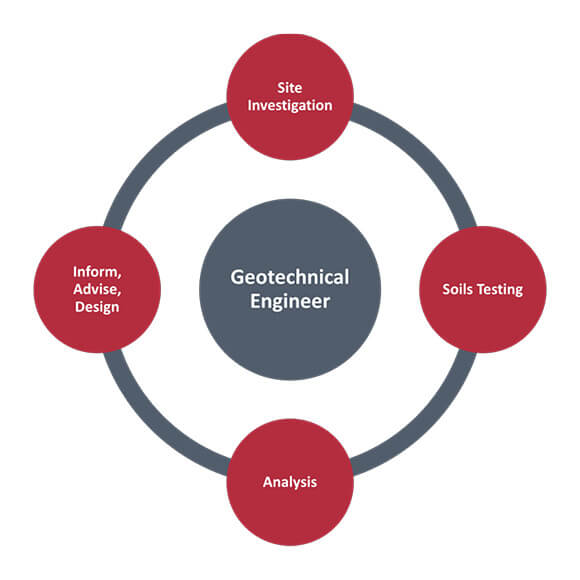9 Easy Facts About Geotheta Explained
9 Easy Facts About Geotheta Explained
Blog Article
The Geotheta PDFs
Table of ContentsWhat Does Geotheta Do?How Geotheta can Save You Time, Stress, and Money.The Ultimate Guide To GeothetaSome Ideas on Geotheta You Need To Know
They team up with civil engineers, structural designers, engineers, and other experts to integrate geotechnical considerations right into the general task style and building and construction procedure. This needs reliable synergy, sychronisation, and communication to make sure that the geotechnical aspects align with the project purposes and fulfill regulative demands.Mining & Materials Engineering: Concepts of drilling, penetration rates, and variables affecting the option of drilling method. Features of nitroglycerins, shooting systems and blast patterns. Blasting methods in surface and below ground workings. Special blowing up strategies at excavation boundaries. Vibration and sound control. Mechanical and continual approaches to fragmentation, consisting of longwall shearing and fullface boring.
Modelling of piece and bit dimension circulations; comminution as a transfer function. Comminution innovation: squashing, grinding, dimension classification. Integrated evaluation of fragmentation and comminution procedures. Offered by: Mining & Materials Engineering.
See This Report about Geotheta
Bachelor's degree programs in civil, geotechnical, geological, and ecological design normally last four years and include general education and learning courses in English, social science, and the humanities, as well as programs in innovative maths, architectural geology, and liquid mineralogy. (https://sketchfab.com/geotheta)
Geotechnical engineering involves the assessment of the soil and rock conditions at a specific site, and their implications for the advancement of that website. As many frameworks depend on the ground for assistance, it is without surprise that an in-depth understanding of the ground problems, and the suitability of foundation systems, are essential to the long-term security and efficiency of the building or framework.
Being experts in the examination of geological developments and ground practices, geotechnical engineers carry out clinical examinations and testing to understand the influence these geological developments might have on the design and construction of building, civil and framework tasks. This experience is vital for the layout and building of buildings, roadways, passages, dams, bridges, and water and sewage systems.
The geotechnical team at Douglas Allies routinely speak with architects, design engineers, developers, and home builders to make suggestions on layout and development proposals to ensure that the built structures are appropriately made for the ground problems. The style of footing systems needs to take into consideration the weight of the framework, the ability of the ground to support that weight with each other with activity tolerances and efficient construction.
Unknown Facts About Geotheta
This job is significantly simplified by the usage of our Douglas Map geospatial system which makes this details easily accessible in a very easy to utilize internet browser user interface. A geotechnical engineer will certainly direct the drilling of boreholes and examination pits to gather dirt and various other examples, and also assess surface area features and ground direct exposures to form a geotechnical version of the subsurface conditions.
Relying on the task kind and ground problems experienced, research laboratory screening might to name a few points evaluate toughness, compressibility, reactivity and/or leaks in the structure of dirt and rock samples. After this data is gathered and looked at, the outcomes are made use of for a geotechnical model of the site, which is usually offered as sections across the website.

A geotechnical examination naturally can just examine the ground problems at the places pierced or dug deep into. All-natural variations in soil and rock problems can occur across a site and between test places. It is therefore good practice that the geotechnical engineer be maintained throughout building of the job to provide on-site confirmation that the ground conditions run into follow the expectations and advice given in the geotechnical examination report.
Geotheta - Truths
Geotechnical engineers use their extensive expertise of dirt and rock to evaluate risk and address problems on diverse facilities projectsGeotechnical design is a specialist branch of civil engineering which takes a look at the behavior of earth products and the application of soil and rock auto mechanics. Consulting Engineer. As a geotechnical designer, you will certainly assess the physical, mechanical and chemical residential or commercial properties of dirt and rock in look these up order to design structures, retaining frameworks and earthworks
Geotechnical engineering is closely linked to and overlaps with, both engineering geology and ground design - https://www.tripadvisor.in/Profile/geotheta1. It's possible to be experts in geotechnics or job for a geotechnical company but be recognized as a design geologist or a ground designer. As a geotechnical designer, you'll need to: develop and preserve connections with customers and other professionals entailed in the website, throughout each projectmaintain safety and security criteria on website bear in mind expense ramifications when you make recommendationsstudy geological maps and aerial photographs from a range of resources and from different time periodsexamine building and construction intends to see how feasible they are based upon your understanding of the siteinvestigate threats or geological threats for the sitesearch for environmentally sensitive functions, such as land fill beginning to create valid and interpretive ground modelsplan area investigationsdrill and analyse examples of bedrock, soil, groundwater and additional materials manage various other professionals on sitesolve technological concerns as they emerge, such as unforeseen structures at drill sitesmonitor problems throughout and after construction to ensure structures are steady in the brief and long termadding information gathered on site to your initial researchcreating geotechnical computations, illustrations, and two or three-dimensional computer system models translating the datamaking referrals regarding the recommended use of the site

Report this page